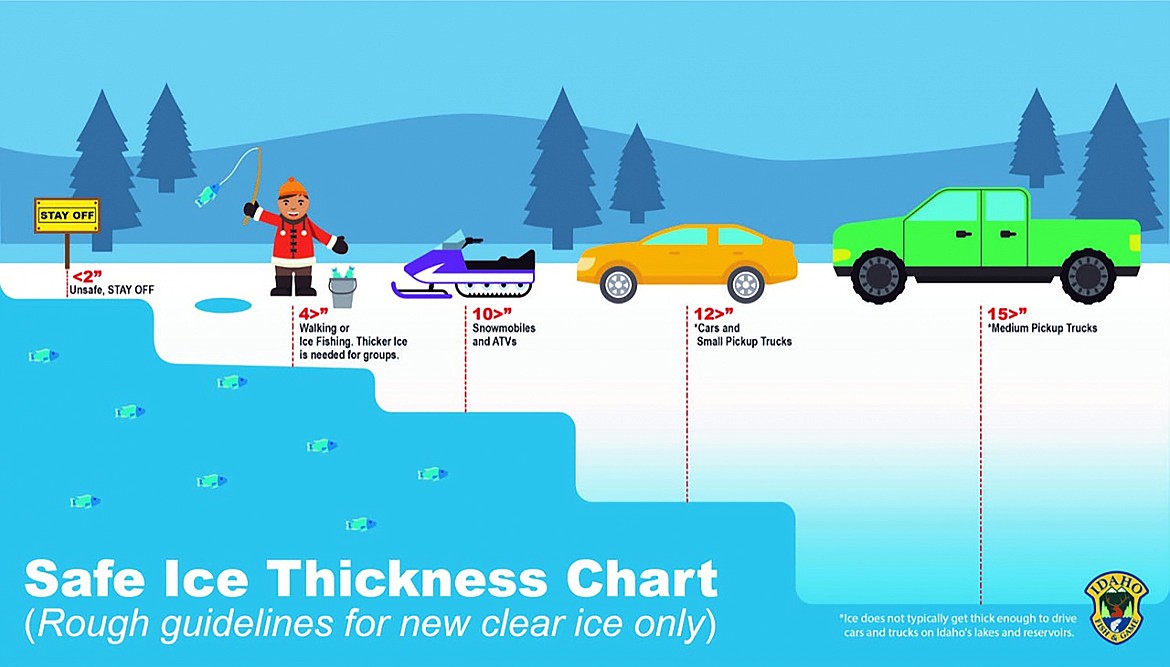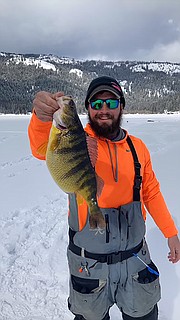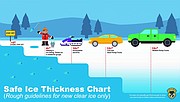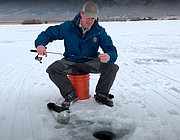Anglers chill out on region's lakes
CONNOR LIESS/Contributing Writer | Bonner County Daily Bee | UPDATED 3 years, 2 months AGO
Ice gets a bad rap this time of year. It glazes your windshield, covers your driveways and makes the highways slicker than snot. But when it comes to lake fishing during winter, ice is a bonus. One of the hottest opportunities (figuratively speaking) to catch fish is ice fishing. It's a fun and surprisingly user-friendly way to keep fishing in the dead of winter. Because there's no limit to space on the ice, you can bring all your friends and family and make it a party.
Aside from your usual fishing gear, all you need is an ice auger and a slush spoon. From there, you can keep it basic, or make your ice-fishing set up as elaborate as you want by adding a sled, tent, fish finders, tip-ups and other cool gadgets.
Fish and Game fisheries staff are optimistic about this year’s ice fishing conditions.
“Ice fishing opens up an opportunity for anglers to catch alternative fish species they may not be targeting during the warmer months. Lake Cascade, for instance, arguably Idaho’s number one ice fishing destination, holds a variety of fish, from kokanee salmon, rainbow trout, bass, muskie and of course, the fabled ‘jumbo’ perch," said Southwest Regional Fisheries Manager Jordan Messner.
ICE ACCESS AND SAFETY
When choosing a place to go ice fishing, pay close attention to access. You will need a parking area and an easy place to walk onto the ice. If you have been to a lake or reservoir during summer, those access sites could be blocked by snow. Fish and Game partners with various agencies to help provide ice fishing access by maintaining winter parking lots in many locations.
Before racing out on to the ice like Olympic speed skater Apolo Ohno, anglers must ensure safe ice conditions — a minimum 4 inches of clear, solid ice is recommended for anglers on foot.
It can be a bit of a challenge checking the ice status of your favorite lake or reservoir. Idaho is a diverse state when it comes to climate and geography, so conditions could be hit or miss depending on when you’re looking to go.
WHERE SHOULD I GO?
Whether you’re up in the Panhandle or hugging the Utah border down in the Southeast region, the Gem State has no shortage of destination ice fisheries. From world-record perch in Cascade to trophy rainbow trout in Henrys Lake, Idaho is home to a wide array of lakes and reservoirs, so it might be a little daunting to pick one for the upcoming weekend. Check out this list of some of the state's top ice fishing destinations.
Just like Idaho weather, ice quality can vary across the state. As a good rule of thumb, check ice fishing conditions by calling your local Fish and Game region office before making any long treks out of town.
Depending on where you go, be sure to review the fishing destination’s bag limits and check for any season closures. And if you're new to the sport, the video below gives anglers a great look into ice fishing from a beginner's standpoint.
GETTING IN GEAR
Ice fishing is exactly what it sounds like: Armed with nothing more than a rod, some basic bait and tackle, a valid Idaho fishing license and a well-placed hole in the ice, anglers can find a relatively inexpensive and exciting way to stay busy during the colder months. But anglers should also look into some other gear they may want to add to their lineup.
Sleds
Whether you’re walking, skiing, or snowmobiling to your ice fishing spot, having a small sled to store your gear in can be really nice. This will help you stay mobile and be able to move around the lake more as the fish move.
Ice Auger
It’s a little hard to ice fish when the fish are protected by 5 inches of ice. Augers and scoops don’t have to be fancy. Depending on the size of fish you’re targeting, you’ll need anywhere from a 5-inch to a 10-inch hole (10 inches is the maximum hole size in Idaho). Small hand augers are really light weight and easy to use, and many of them can be used with the aid of a cordless power drill. Some new ice augers are powered by lithium batteries making them really lightweight and reliable (as long as the battery is charged). Pro-tip: Keep your lithium battery inside your jacket to keep it warm — otherwise you may get all the way out to your spot and your battery is dead. Gas powered augers are another reliable option, and are much less costly than the new lithium products.
Scoop
Add a slotted spoon or ice scoop to your tackle box. Having a tool that isn’t your bare hand to scoop out the slush around an ice hole is a game changer. Don’t be caught without one.
Maps and Electronics
Figuring out where the fish are is the most important aspect of ice fishing. There are two pieces of technology that can really up your game in terms of finding fish. The first one is a bathymetric map of the lake (contour map). Being able to locate shallow versus deeper areas of the lake, drop-offs, and underwater channels can be a game changer. There are several companies online that sell these. Do you research and find the best one for the lake you’re going to fish.
The second piece of gear that will help you find fish is a fish finder. The options are almost overwhelming when you look at all the different types of fish finders out there. Ranging in price from $200 to over a thousand dollars, the only similarity between them all is that they aren’t cheap, but they’ll greatly increase your chances of catching fish. Using a fish-finder allows to you see if the fish are there or not. If they’re there but you’re not catching any — try changing up your bait or your presentation.
SOME HOT TIPS
Now that you got your prime ice fishing spot scoped out and have confirmed its ice conditions are safe, here are a few hot tips to keep in your back pocket.
Bring some cushion. Unless you like having only a layer of polyester between your rear and the ice, it’d be a smart move to bring something to sit on. Not only will it keep you slightly warmer, it will be a lot more comfortable in the long run.
Use electronic fish finders. Knowing where the fish are can save you a lot of time and headache when prospecting for fish on thick ice.
Dress warm. That may sound obvious, but adding an extra layer or two to your backpack might serve you well in case of unpredictable weather.
Don’t venture too far out. Most anglers have the best luck in around 5 to 20 feet of water.
And lastly (and most importantly) stay mobile. If you don’t get any tugs after 10-20 minutes at a spot, keep moving. Just because a fishing spot is hot in the summer, doesn’t necessarily mean it will be come winter time.
Be sure to check out Fish and Game’s Idaho Fish Planner to learn more about each ice fishery, safety tips, access sites and seasons and regulations, and to plan out your next weekend fishing trip. Be sure to check out Fish and Game’s ice fishing webpage for more details.
• • •
Connor Liess is a public information specialist for Idaho Department of Fish & Game.
MORE OUTDOORS STORIES








